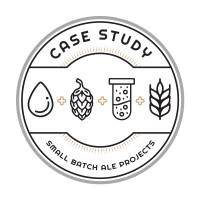Brew Log History
Ambient: {{ stats.ambient | number:0 }} °F
OG: {{ stats.ogGravity | number:3 }}
Attenuation: {{ stats.attenuation | number:2 }}%
Calories: {{ stats.calories | number:1 }} / 12oz
Carbs: {{ stats.carbs | number:1 }} g / 12oz
Readings: {{ readingsCount | number }}
{{ formatHeaderDate(dates.navStart) | date:'mediumDate' }} to {{ formatHeaderDate(dates.navEnd) | date:'mediumDate' }}
Last Updated: {{ stats.lastupdated.ago }} from {{ stats.lastupdated.source }}
Mash Guidelines
|
Amount
|
Description
|
Type
|
Start Temp
|
Target Temp
|
Time
|
|
1.35 gal |
|
Strike |
157 °F |
148 °F |
30 min |
|
0.25 gal |
|
Infusion |
212 °F |
158 °F |
30 min |
|
1 gal |
|
Sparge |
212 °F |
180 °F |
30 min |
Starting Mash Thickness:
1.8 qt/lb
Starting Grain Temp:
70 °F |
Target Water Profile
Balanced Profile
Notes
1) Use unpasteurized Apple Cider from farm OR cider from the store that does not contain sulfite, sorbate, or benzonate, as these actively prevent fermentation. 1 Gallon = 8.35 pounds
2) Grains are used to provide natural nutrients to yeast as well as a more complex flavor and body. Mash grains as normal, adding in brown sugar and cider at sparge. Bring everything to 180 F for 5 minutes for the pasteurization of cider, then cool to room temperature. Add campden tablets.
3) Campden Tablets releases sulphur dioxide, which acts as a sterilant and antioxidant. Use one tablet per gallon Contains potassium metabisulphite. Each tablet contains 450mg of active sulphite per tablet. Two crushed tablets equal 1/4 tsp. Let sit for a day so sulphur dioxide can off gas out of fermentor.
4) If using fresh-pressed cider, Pectic Enzyme will help with clarification. Do this 12-24 hours after campden tablets. Add ½ teaspoon per gallon of must before start of fermentation in wine or fruit beers of pectic enzyme to get a better yield from fruit and to help with clarity. This will coagulate the pectins and drop them out of suspension.
5) WLN 1000 Use to increase health of yeast. Contains diammonium phosphate, essential vitamins and cofactors, nitrogen (amino acids, proteins and peptides) and minerals. White labs yeast nutrient is an effective boost for first and or late generation yeast slurry. Use .5 teaspoon for 5 gallons. Use 2X normal amount for cider (Per Chris Smith of NB). Add this and the yeast at the same time as the pectic enzyme, mix well, and then proceed to primary fermentation. Final Gravity will likely be BELOW 1.000 and that is OK.
6) After primary fermentation has ended, transfer to secondary and add cinnamon sticks and leave in secondary to taste.
7) Super-Kleer can also be used as a final fining agent to clarify the cider.
8) If kegging and back sweetening, add potassium sorbate as a stabilizer. This will prevent further fermentation. Use 1 tsp per gallon.
For further reading also see: http://brulosophy.com/2018/09/06/chemical-vs-heat-pasteurization-of-fresh-pressed-juice-when-making-hard-cider-experiment-results/

Last Updated and Sharing

- Public: Yup, Shared
- Last Updated: 2020-09-19 18:45 UTC
For quick copying and pasting to a text based forum or email.
Click the Download as HTML file button below.
Recipe costs can be adjusted by changing the batch size. They won't be saved but will give you an idea of costs if your final yield was different.
|
Cost $ |
Cost % |
| Fermentables |
$ |
|
Steeping Grains
(Extract Only) |
$ |
|
| Hops |
$ |
|
| Yeast |
$ |
|
| Other |
$ |
|
| Cost Per Barrel |
$ 0.00 |
|
| Cost Per Pint |
$ 0.00 |
|
| Total Cost |
$ 0.00 |
|
Discussion about this recipe:





